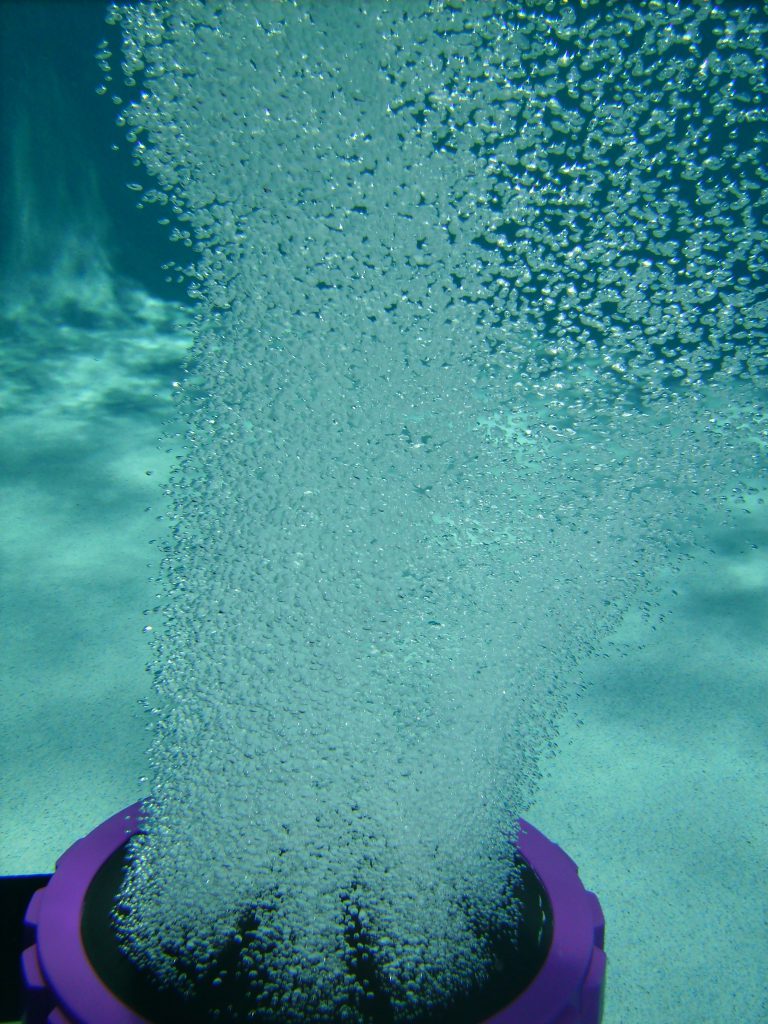
Much like managing turf, it takes a trained eye and a lot of experience to manage a pond. While the science behind managing a pond can be difficult, there is one thing that every pond should have: aeration. Before biological, chemical, or herbicidal treatments are explored, adding aeration should be considered.
Can you imagine managing your turf only when signs of distress are evident, and allowing years to go by before any action is taken to maintain its health? For many pond owners, their pond management strategy begins when the problems are at their worst. Have you ever seen an unhealthy pond with murky water and clumps of slimy green algae growing across the surface, or a collapsing shoreline due to severe erosion? No doubt it had a foul odor, too. What you experienced was a pond that had not been managed.
The Cause of Unhealthy and Unsightly Water
The unsightly condition and foul odor are symptoms of a pond that has been neglected for far too long. The pond manager may have attempted to control the algae by adding some copper sulfate, which probably worked pretty well at first but now doesn’t do much to balance the long-term health of the pond. In some cases, you may even swear it makes the algae worse. Remember, algae and other nuisance aquatic vegetation and odors are just the symptoms of an unbalanced water body. If a pond manager has any hope of bringing back the health of the pond, the problem must be solved at the source, and not by only addressing the symptoms.
Many times, pond issues occur due to a lack of oxygen in the water and the accumulation of organic matter in the pond. As a pond ages, the organic matter forms a layer of muck on the bottom, where oxygen levels tend to be very low. The muck on the bottom of the pond is full of nutrients and noxious gases that can be smelly or even potentially toxic. This lack of oxygen does not allow the beneficial bacteria available in the water to break down the organic matter and use up the excess nutrients in the pond. These beneficial bacteria need oxygen to survive and metabolize nutrients. Therefore, nutrients accumulate in the pond and become a food source for algae and nuisance aquatic weeds. A pond under these conditions is said to have “thermal stratification.” This means there is a layer of cool, low-oxygen water on the bottom and warm water at the surface of the pond.
How Thermal Stratification Can Impact Pond Water Quality
Thermal stratification is a seasonal effect on a pond. In the summer months when the air temperature is hot, the surface of the pond warms up and the bottom remains cool. In the winter, the surface of the pond is cold and the bottom is warmer. In the spring and fall seasons, the pond water will invert and cause the layers to flip. This can be a very stressful time for a pond, and especially for the fish that live in it. When the low oxygenated water flips to the surface, fish can suffocate and result in a fish kill in the pond.

Thermal stratification can be eliminated by adding aeration. Aeration will help to mix the entire water body and prevent low-oxygen conditions at the bottom of a pond. Aeration works by creating circulation and movement to expose as much water to the atmosphere as possible. With more water in contact with the atmosphere, more oxygen can be adsorbed to the water molecules. This higher concentration of oxygen in the water will allow for more beneficial bacteria that can help to metabolize excess nutrients and reduce muck accumulation at the bottom of the pond.
These more favorable conditions will greatly improve water quality and pond aesthetics and make managing the pond easier. In addition, algae and weed growth will be decreased, which means fewer treatments are needed to maintain a healthy pond. Give your pond the best chance to be healthy: shut the muck down and aerate your pond.









